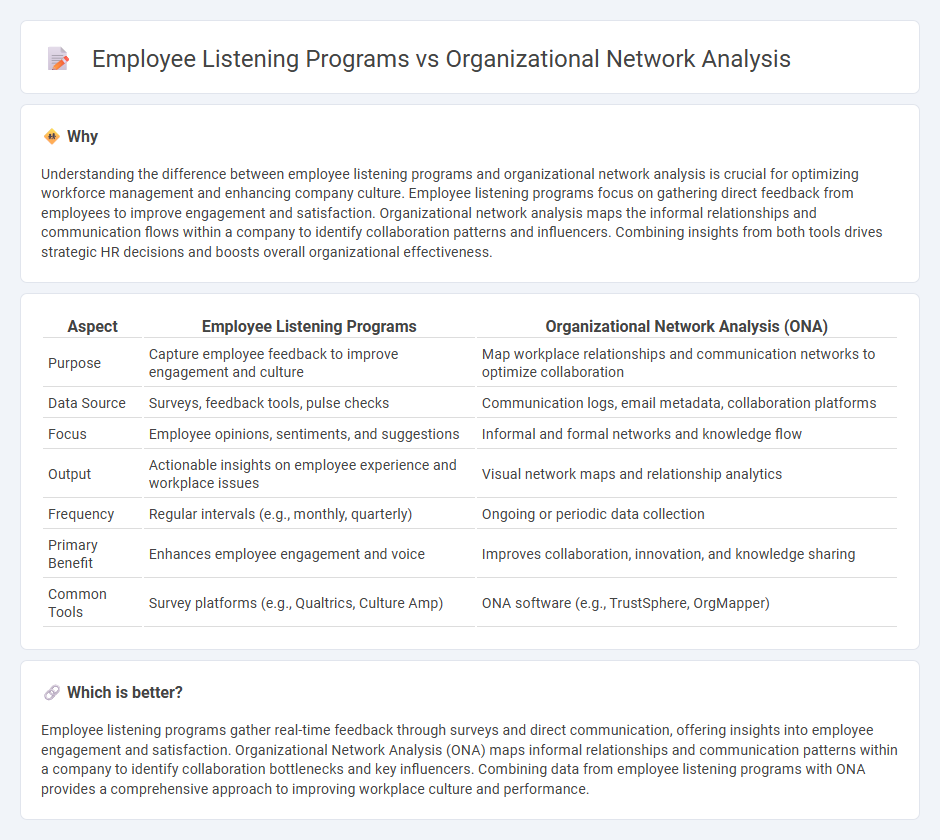
Employee listening programs capture direct feedback through surveys, focus groups, and suggestion boxes to gauge workforce sentiment and improve engagement. Organizational Network Analysis (ONA) maps informal relationships and communication patterns within a company to reveal collaboration bottlenecks and knowledge flow. Explore the strategic benefits of combining these approaches to enhance human resource management.
Why it is important
Understanding the difference between employee listening programs and organizational network analysis is crucial for optimizing workforce management and enhancing company culture. Employee listening programs focus on gathering direct feedback from employees to improve engagement and satisfaction. Organizational network analysis maps the informal relationships and communication flows within a company to identify collaboration patterns and influencers. Combining insights from both tools drives strategic HR decisions and boosts overall organizational effectiveness.
Comparison Table
| Aspect | Employee Listening Programs | Organizational Network Analysis (ONA) |
|---|---|---|
| Purpose | Capture employee feedback to improve engagement and culture | Map workplace relationships and communication networks to optimize collaboration |
| Data Source | Surveys, feedback tools, pulse checks | Communication logs, email metadata, collaboration platforms |
| Focus | Employee opinions, sentiments, and suggestions | Informal and formal networks and knowledge flow |
| Output | Actionable insights on employee experience and workplace issues | Visual network maps and relationship analytics |
| Frequency | Regular intervals (e.g., monthly, quarterly) | Ongoing or periodic data collection |
| Primary Benefit | Enhances employee engagement and voice | Improves collaboration, innovation, and knowledge sharing |
| Common Tools | Survey platforms (e.g., Qualtrics, Culture Amp) | ONA software (e.g., TrustSphere, OrgMapper) |
Which is better?
Employee listening programs gather real-time feedback through surveys and direct communication, offering insights into employee engagement and satisfaction. Organizational Network Analysis (ONA) maps informal relationships and communication patterns within a company to identify collaboration bottlenecks and key influencers. Combining data from employee listening programs with ONA provides a comprehensive approach to improving workplace culture and performance.
Connection
Employee listening programs gather real-time feedback and sentiment data, which organizational network analysis (ONA) uses to map communication patterns and informal relationships within a company. By integrating these approaches, HR professionals can identify engagement hotspots, collaboration bottlenecks, and hidden influencers crucial for workforce planning and performance improvement. This synergy enhances decision-making by aligning employee experiences with structural insights to drive effective talent management strategies.
Key Terms
**Organizational Network Analysis:**
Organizational Network Analysis (ONA) maps and measures the informal relationships and communication patterns within a company to identify key influencers, information flow, and collaboration gaps. ONA leverages data from emails, meetings, and social interactions to provide a granular view of organizational dynamics, enabling more strategic decision-making and enhanced agility. Explore how ONA can transform your organizational insights beyond traditional employee listening programs.
Social Connections
Organizational Network Analysis (ONA) maps and measures the actual social connections and information flows within a company, revealing informal relationships and collaboration patterns. Employee listening programs gather direct feedback from employees to understand their experiences, sentiments, and engagement levels, offering qualitative insights into workplace culture. Explore how integrating these approaches can enhance your understanding of social dynamics and improve organizational effectiveness.
Communication Patterns
Organizational network analysis (ONA) systematically maps and measures communication patterns within a company, identifying key influencers and information flow efficiency, while employee listening programs gather direct feedback through surveys and open forums to understand employees' sentiments and concerns. ONA leverages data-driven insights from digital communications to reveal informal networks and collaboration gaps, contrasting with the qualitative and quantitative data derived from listening tools that capture explicit employee experiences. Explore how integrating both approaches can enhance your understanding of workplace dynamics and improve communication strategies.
Source and External Links
What is Organizational Network Analysis (ONA)? - Rob Cross - Organizational network analysis (ONA) is a tool that measures and visualizes patterns of collaboration and influence within organizations, revealing hidden connectors critical to information flow and organizational success beyond formal structures.
Organizational Network Analysis: A Strategic Tool - HRBrain.ai - ONA maps connections between people, teams, and groups to identify communication barriers and key influencers, enabling organizations to improve collaboration, decision-making, and information flow across regions or remote teams.
How to Conduct an Organizational Network Analysis: Step-by-Step ... - Visible Network Labs - Conducting ONA involves defining objectives, planning, collecting data on relationships, mapping the network visually, analyzing patterns and key nodes, and applying insights to improve organizational processes and collaboration.
 dowidth.com
dowidth.com